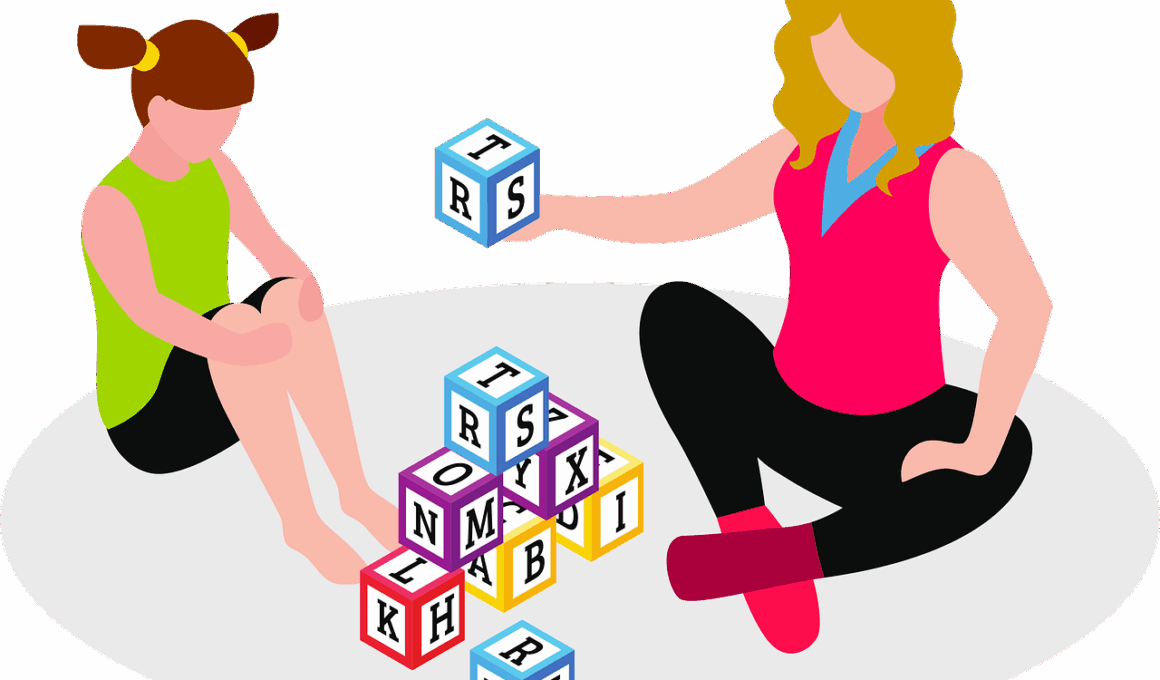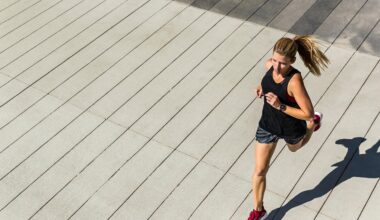Assessing Individual Needs for Adaptive Physical Education
Adaptive Physical Education (APE) serves a vital role in promoting inclusion within educational institutions. Every student, including those with disabilities, should have the opportunity to engage in physical activity effectively. Assessing individual needs in APE is crucial to tailor programs that fit each student uniquely. It begins with gathering comprehensive data through various methods such as interviews and physical assessments. Teachers, parents, and therapists may provide valuable insights about a child’s physical capabilities and social-emotional needs. Furthermore, schools must ensure adequate training for teachers, enabling them to understand diverse disabilities and their impact on physical activity participation. An effective strategy involves setting measurable goals and objectives in collaboration with all stakeholders. Utilizing adaptive equipment could enhance participation levels significantly. Students can thrive in environments where educators focus on developing their strengths while addressing any limitations. Adaptation is not merely a response to challenges but a proactive means of fostering self-esteem and confidence. Ultimately, whether athletics or daily exercises, individualized programs can create a more inclusive atmosphere, making every child feel valued and empowered. With the right approach, APE can forge lifelong beneficial habits in students with disabilities.
Alongside assessing individual needs, understanding the legal framework surrounding adaptive physical education is essential. Legislation like the Individuals with Disabilities Education Act (IDEA) focuses on providing equitable access to education and related services. Schools must comply by developing Individualized Education Programs (IEPs) tailored to specific needs. IEPs should include detailed physical education objectives that account for the students’ unique requirements, helping guide the evaluation process. Moreover, formative assessments assist in tracking progress, ensuring that APE programs remain effective and adaptive over time. Schools are encouraged to embrace ongoing professional development to remain updated on best practices in APE. Collaboration among physical educators, special education staff, and health professionals results in the creation of a supportive environment. This environment can help cultivate well-rounded individuals who excel not just physically but also socially and emotionally. Peer involvement within APE can foster understanding, empathy, and teamwork among students of all abilities. Working together, teachers and administrators can dismantle barriers, allowing students with disabilities to experience the joys and benefits of physical education. These efforts must be continual, evolving as students’ needs and capabilities grow throughout their educational journey.
Incorporating technology into assessments can enhance the adaptation process in APE. Tools such as apps and software can aid in tracking student progress meticulously. Additionally, differences in student learning styles should influence the use of these technologies. For some learners, visual aids can enhance comprehension, while for others, kinesthetic methods might resonate more strongly. Thus, integrating various types of technology allows schools to cater to diverse needs more effectively. Gathering feedback from students is vital; they often have insights into what adaptations improve their experience. Encouraging self-advocacy and participation in their program can significantly impact their engagement level. This empowerment helps students develop confidence and promotes personal growth outside the classroom. Furthermore, regular evaluations allow educators to adjust and refine strategies to optimize student success. Teachers should also emphasize the importance of teamwork in APE, fostering relationships that inspire support and camaraderie. When students work together and support one another, they build a sense of community that enriches their educational experience. This holistic approach ensures that curriculum modifications keep students challenged, motivated, and engaged in physical education activities they genuinely enjoy.
Creating a supportive and understanding culture in APE is key to achieving desired outcomes. Physical educators need to establish strong relationships with students, building trust and rapport over time. This connection encourages students to express their needs openly, enabling better assessments and accommodations. Teachers can utilize warm-ups or icebreaker activities as interaction points, helping students feel more comfortable video in their learning environment. Furthermore, family involvement plays a crucial role in supporting adaptive physical programs. Encouraging parents to participate in assessments and share observations can enhance the program’s effectiveness. Schools should prioritize consistent communication, ensuring families are aware and informed about their child’s progress. To showcase students’ achievements, teachers can implement celebrations or recognition events highlighting the efforts of all young athletes. A positive reinforcement culture motivates students to embrace challenges and celebrate small victories. These achievements, no matter how minor, contribute significantly to overall self-esteem and motivation. As students feel encouraged by their progress, they are more likely to engage willingly with ongoing physical education opportunities. Creating a supportive culture within APE can lead to transformative experiences, fostering resilience and a love for physical activity that lasts a lifetime.
Curriculum Development for Diverse Needs
A well-designed curriculum for Adaptive Physical Education accounts for diverse learning needs and abilities. This process begins with thorough assessments that identify the strengths and weaknesses of each student. Implementing a variety of teaching modalities — such as cooperative learning, inclusive games, or multi-sports formats — can better engage students with differing needs. Flexibility within the curriculum allows educators to tailor activities to individual preferences and limitations. Facilitating differentiated learning promotes a greater sense of achievement among participants, encouraging continuous improvement and engagement. Additionally, adaptive sports programs can be integrated within APE curricula to provide exciting and novel experiences. Including students in selecting preferred activities increased engagement levels and enhanced ownership of their physical education journey. Collaboration with community organizations and local sports clubs can enhance the breadth of experiences offered, making physical education more enjoyable and relevant. Standardized assessments for adaptive sports must consider varying abilities and provide realistic benchmarks for performance. The result is a more comprehensive educational experience where students can thrive, build friendships, and enhance their physical skills outside of school. Focused attention on curriculum development fosters a robust APE environment that empowers and inspires all students.
Teacher training plays a paramount role in the successful implementation of Adaptive Physical Education programs. Professional development opportunities tailored to adaptive education best practices are vital for equipping educators with the necessary skills and understanding. Comprehensive workshops emphasizing disability awareness, resource management, and effective communication strategies can improve the quality of APE. The incorporation of collaborative training with therapists and special education staff can build holistic teaching strategies that benefit all parties. With adequate resources, teachers can feel empowered to create engaging lessons that meet needs. Furthermore, learning from real-life success stories can inspire educators while motivating them to innovate within their teaching practice. The emphasis must also be placed on cultivating compassion and empathy among teachers, enabling them to approach every student with an open mind. Developing personal connections ensures that students feel valued and respected within the classroom. An honored culture is essential for a thriving APE program, as students benefit from supportive peers and understanding educators. Ultimately, investing in comprehensive teacher training is essential for developing Adaptive Physical Education programs that yield success and prepare students for lifelong participation.
To ensure that adaptive fitness environments remain beneficial, it is necessary to evaluate program effectiveness continually. Identifying improvement areas allows for ongoing enhancement and development of APE initiatives. Student and parent feedback can provide valuable insights into the perceived efficacy of the program. Regular assessments not only inform educators but also empower students by demonstrating progress. Additionally, securing funding and resources will support ongoing development within adaptive programs. Forming partnerships with local fitness organizations can help bridge the gap between educational settings and community resources. Engaging local organizations can provide inclusive sporting events that motivate students to remain active and engaged in physical pursuits. Another effective approach is to implement a mentorship system, teaming students with disabilities with peers who can offer support during activities. Building relationships within this framework can contribute significantly to learning experiences. As schools adapt to changes in student needs and technological advancements, the need for continued improvement becomes paramount. Educators should adopt a collaborative approach, sharing best practices and success stories to encourage growth collectively. In doing so, schools can contribute towards an inclusive adaptive fitness landscape, ensuring that every student has ample opportunity to enjoy physical education.
In conclusion, the significance of assessing individual needs for Adaptive Physical Education cannot be overstated. Schools must prioritize inclusivity, equity, and individualized learning to ensure that every student can participate meaningfully in physical education. A robust understanding of students’ unique needs is vital to developing effective programs that inspire confidence, motivation, and overall wellbeing. Through ongoing assessments, adaptive practices, and collaboration among teachers, students, parents, and community partners, educational environments can foster a culture where all students, regardless of their abilities, can thrive. As APE evolves, it will play a critical role in shaping lifelong habits that promote health and fitness among individuals with disabilities. The journey begins in schools, where adaptability must be integrated into each fabric of the physical education curriculum. Whether through traditional sports, recreational activities, or fitness classes, ensuring options exist for every student opens doors to the joys of physical activity. The shared responsibility of educators is to pave the way for these transformations, guiding each child towards achieving their potential. This dedication to adaptive fitness ultimately creates an enriching experience that fosters students’ growth on physical, social, and emotional levels.


